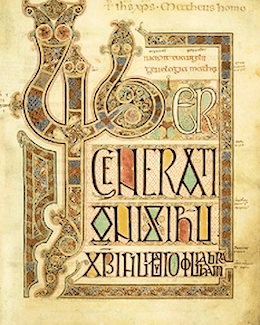Textus Receptus Bibles
Wessex Gospels c.1175
Anglo-Saxon
| 3:1 | On þam dagen com iohannes se fulluhtere & bodede on þam westene iudëë. |
| 3:2 | & cwæð. Doð deadbote. soðlice geneolaceð heofone riche. |
| 3:3 | Þis is se be þam þe gecweþen is. þurh ysia þanne witega. Cleopiende stefne wæs on wæstene. gegearewiað drihtnes weig. doð hys syþas rihte. |
| 3:4 | Se Iohannes witodlice hafde reaf of oluende hære. & fellenne gerdel embe hys lændene. & his mëte wæs gærstapen. & wude-hunig. |
| 3:5 | Þa ferde to hym ierosolim-ware. & eal iudea-þeod. & eal þæt riche wið-geonde iordanen. |
| 3:6 | & hyo wæron gefullode on iordanen fram hym. & hyo andetten hiora synnan. |
| 3:7 | Soðlice þa he geseah manege þare sunder-halgena. & þare riht-wisendre to his fulluhte cumende. he cwæð to heom. La næddrena kyn hwa geswutolede eow to fleonne fram þan toweardan eorre. |
| 3:8 | Eornostlice doð medemne wæstm þare deadbote. |
| 3:9 | & ne cweðeð be-twuxe eow. we hæbbeð abraham us to fæder. Soðlice ich segge eow þt god is swa mychel & swa mihtig. þæt he maig of þisen stanen aweccen abrahames bearn. |
| 3:10 | Eallunge is syo æx to þare treowe wertrume äsett. Eornestlice ælc treow þe godne wæstme ne bringð byð forcorfen. & on fere aworpen. |
| 3:11 | Witodlice ich eow fullie on wætere to deadbote. Se þe æfter me toward ys. he is strengre þanne ich. þas gescy ne eom ich wurðe to berenne. He eow fulleð Note: MS. fulled. on halgen gaste. & on fyre. |
| 3:12 | Ðas fann ys on hande & he afermeð hys þyrscel-flore. & he gadereð Note: MS. gadered. hys hwæte on his bearn. þa chefu he forberneð on unadwæscendlice fyre. |
| 3:13 | Note: Venit iesus á galilea in iordanem ad iohannem ut baptizaretur ab eo. R. Þa com se hælend fram galilea to Iordane to Iohanne, þæt he hine fullode |
| 3:14 | iohannes þa soðlice forbead hym. & cwæð. Ic scel fram þe beon gefullod. & cymst þu to me. |
| 3:15 | Ða andswerede se halend hym. & cwæð. læt nu þus unc geþafenað ealle rihtwisnysse gefullen. Ða forlet he hine. |
| 3:16 | Soðlice þa se hælend gefulled wæs. rædlice he astah of þam wætere. & hym wurðen þær-rihte heofenes untynde. & he geseah godes gast niþer-astigende swa swa culfran. & wunigende ofer hine. |
| 3:17 | And soðlice þa com stefne of hefene. & þus cwæð. Her is min se gecorene sune on þam me gelicode. |

Wessex Gospels c.1175
The Wessex Gospels (also known as the West-Saxon Gospels) are a full translation of the four gospels of the Christian Bible into a West Saxon dialect of Old English. Designated Royal MS 1 A XIV, it is historically important.
- The Wessex Gospels are the oldest translations into English without the Latin.
- The gospels are written in the Old English West Anglo-Saxon dialect of Northumbria.
- Royal MS 1 A XIV is written on parchment and is also known as the Codex Evangeliorum Anglice.
- The title written at the top of the page, ‘Text[us] iv evangelior[um] anglice’, is reproduced in the 14th-century catalogue of the Benedictine Christ Church library, but at the Reformation this book was one of many acquired from religious houses by Thomas Cranmer, Archbishop of Canterbury from 1532 to 1534, whose name is written at the top of the page.
- Seven extant copies exist today. The earliest version dates from 990AD.
- Royal MS 1 A XIV was copied directly from MS 441 in the Bodleian library at Oxford. We know this as the same passages have been omitted from both. It has a transmission jump of 185 years.
- MS 441 (990AD) is extant and still resides in the Bodleian Library at Oxford University, England. It was given to the library by Baron Hatton in 1671. Paleographical evidence suggests a Canterbury origin. The earliest extant evidence of ownership is through Archbishop Matthew Parker (1504-75).
- MS Corp. Ch Coll Camb 140 (1000AD) is in Corpus Christi College Cambridge.
- Royal MS 1 A XIV (1175AD) is in the British Library and was presented to the British Museum by King George II in 1757 from the Old Royal Library.
- Royal MS 1 A XIV once belonged to the Prince of Wales: Henry Frederick, (1594-1612), eldest child of King James the First.
Why is this important?
- Desiderius Erasmus had access to these MSS before starting his translation of the Textus Receptus. In the five years prior to starting his translation work Erasmus was Professor of Divinity at Cambridge at a time when the university's benefactors owned these manuscripts.
- The King James Bible translators had access to these manuscripts. All the six KJV translation companies where housed at Oxford, Cambridge and Westminster and all had access to the Wessex Gospels.
- The codex contains the long ending in Mark chapter 16.
- The codex contains the Pericope Adulterae (John 7:53-8:11)